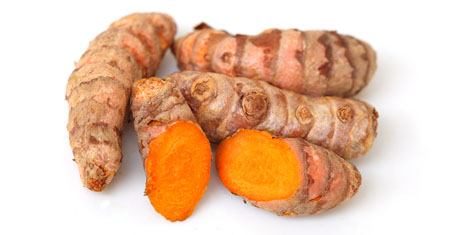What Is Turmeric?

The turmeric plant, or Curcuma longa, is an herb closely related to ginger. It's cultivated in tropical climates across Asia for its rootstocks, which supply the flavor and pigment of the plant. The rootstocks - which grow underground, but are more of a stem than a true root - can be ground into a paste, or dried and ground into a powder.
Turmeric Plant and Cultivation
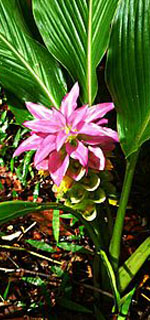
Turmeric is a tropical herb and is grown in both tropics and subtropics. It will grow luxuriantly in shade if not too dense, but it produces larger and better rhizomes in the open ground exposed to the sun. Turmeric require humid climate. Mother rhizomes are used for planting and well developed healthy and disease free rhizomes are to be selected. Small pits are made with a hand hoe in the beds in rows with spacing of 25 cm x 30 cm and covered with soil or dry powdered cattle manure. The optimum spacing in furrows and ridges is between 45-60 cm between the rows and 25 cm between the plants. A seed rate of 2,500 kg of rhizomes is required for planting one hectare of turmeric. Planting season varies with the area of cultivation and variety. Planting is done during May-June or July- August in different tracts. Usually harvesting extends from January to March-April. Early varieties mature in 7-8 months and medium varieties in 8-9 months. The crop is ready for harvesting when the leaves turn yellow and start drying up. The picked rhizomes are collected and cleaned. Harvesting is done by either manually or by mechanical.
Turmeric Description
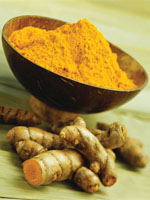
The turmeric plant is identifiable by both its characteristic tuberous root and the leaves that extend upward from erect, thick stems arising from the root. Turmeric root is actually a fleshy oblong tuber 2–3 in (5–10 cm) in length, and close to 1 in (2.54 cm) wide. It is tapered at each end, and its exterior can be yellow, tan, or olive-green in color. The interior of the root is hard, firm, and either orange-brown or deeply rust-colored, with transverse resinous parallel rings.
Turmeric root has a fragrant aroma and a somewhat bitter, peppery, biting taste reminiscent of ginger. When eaten, it colors the saliva yellow and leaves a warm sensation in the mouth.
Uses of Turmeric
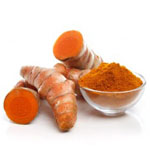
Turmeric is used as a spice in curry powders and mustard and has also been used for making a deep yellow dye for fabrics for hundreds of years, though it does not produce an enduring color-fast tint. It is being investigated in clinical trials for the treatment and prevention of cancers, particularly of the gastrointestinal tract, and for treatment of colitis and Alzheimer and Huntington diseases. A less familiar use of turmeric is in chemistry, in the making of papers to test for alkaline solutions. White paper soaked in a tincture of turmeric turns reddish-brown and dries to a violet color when an alkaline solution is added.
10 Health Benefits of Turmeric
1 - Alzheimer’s disease - Studies have shown that the extracts of turmeric contain a number of natural agents that block the formation of beta-amyloid, the substance responsible for the plaques that slowly obstruct cerebral function in Alzheimer’s disease.
2 - Arthritis - Turmeric contains more than two dozen anti-inflammatory compounds, including sixdifferent COX-2-inhibitors. The component in turmeric most often cited for its healthful effects – is a multifaceted anti-inflammatory agent, and studies of the efficacy of curcumin have demonstrated positive changes in arthritic symptoms.
3 - Prevent Cancer - Turmeric has been successful in preventing a variety of cancer strains. There is also evidence showing that the curcumin within turmeric can halt the advance of cancer cells or even outright destroying cancerous cells. This is likely attributed to the activate components within the substance, chiefly curcumin, which makes it an excellent preventative measure for radiation-based tumors. Further, it has been shown to be quite effective at preventing T-cell leukemia and carcinomas of the breast and colon.
4 - Helps Wounds Heal - Turmeric (curcumin) has beneficial properties that appear to speed the wound healing process. As new studies come to light showing turmeric’s ability to potentiate the body’s natural healing processes and outcome, the possible breadth of applications could be enormous.
5 - Encourages Balanced Blood Sugar - The effects of curcumin on the insulin-producing cells of the pancreas called Beta cells (or B-cells) and Islet cells, in relation to type-2 diabetes. Researchers treated B-cell lines and human Islet cells with preparations of turmeric and reported a number of positive benefits.
6 - Digestion Improvement - When consumed raw while suffering from a digestive problem, turmeric can help treat the condition. The major components of the spice stimulate the gallbladder to produce bile, instantly making the digestive system more efficient. It is also known to reduce symptoms of bloating and gas.
7 - Immunity Booster - Lipopolysaccharide - a substance in turmeric with anti-bacterial, anti-viral and anti-fungal agents helps stimulate the human immune system.
8 - Liver Detoxifier - Turmeric is known to increase the production of the vital enzymes that detoxify our blood in the liver by breaking down and reducing the toxins. By improving blood circulation too, turmeric is instrumental in promoting good liver health.
9 - Reduces Inflammation - Curcumin may help relieve inflammation and joint pain in some areas of the body. Try adding turmeric into your daily diet to reduce the painful effects of osteoarthritis or other conditions that can cause inflammation.
10 - Improves Cardiovascular Health - Turmeric might help lower your risk of cardiovascular disease by helping to lower the levels of harmful cholesterol in your blood. On top of dropping LDL levels, turmeric may also be involved in reducing the inflammation that can damage blood vessels and lead to cholesterol plaque buildup.
Producing Countries of Turmeric

India is the major producer of turmeric, and it is also the major user of its own production. Other producers in Asia include Pakistan, Bangladesh, Sri Lanka, Taiwan, China, Burma(Myanmar), and Indonesia. Turmeric is also produced in the Caribbean and Latin America: Jamaica, Haiti, Costa Rica, Peru, and Brazil.
Consuming Countries of Turmeric

Asian countries usually consume a large share of their own produce and India stands at the top in this case also. The major importing countries of turmeric are Japan, Sri Lanka, Iran, United Arab Emirates, United States, United Kingdom, Ethiopia.
Recipe for Beverages with Turmeric
Golden Milk
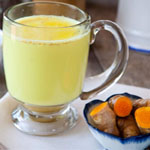
Ingredients: A: 2 cups coconut milk B: 1 teaspoon turmeric C: 1/4 teaspoon black pepper D: 1″ piece of ginger sliced E: Raw honey to sweeten, if desired
Preparation MethodA: In a saucepan add all ingredients (except honey, if using) and whisk to combine. B: Heat over medium heat until it starts to bubble C: Then turn heat down to low and simmer for about 5 minutes so the flavors meld D: Strain out the ginger E: Add honey and stir F: Makes 2 servings
Recipe for Cooking with Turmeric
Bulgur Wheat Balls
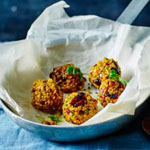
Ingredients: A: 200g/7oz bulgur wheat B: 2 medium free-range eggs C: 1 small red onion, finely chopped D: 2 heaped tsp turmeric E: 2 heaped tsp ground cumin F: 1 tsp ground cinnamon G: ½ tsp cayenne pepper H: 20g/½oz fresh coriander, chopped I: 80g/3oz dried cranberries J: salt and pepper, to taste K: 4 tbsp olive oil
Preparation MethodA: Cook the bulgur wheat for a little longer than the packet instructions say, so it’s very puffy (about 20 minutes). Rinse under cold water to remove the starch and leave to drain until cool enough to handle. B: Preheat the oven to 180C/160C Fan/Gas 4. C: Mix all the ingredients, except the oil, for the bulgur wheat balls together. Squeeze the mixture using your hands so it sticks together. Shape the mixture into golf-ball sized balls or patties, don't worry about making them into perfect balls. Place in the fridge for 30 minutes. D: Heat a large frying pan and add the oil, once hot add the balls and fry or 3-4 minutes. Finish them in the oven for 5-10 minutes if you like.
Recipe for Dessert with Turmeric
Semolina Turmeric Cake
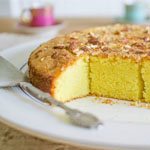
Ingredients: A: 1 1/2 cups semolina flour B: 1/2 cup all-purpose flour C: 1 teaspoon ground turmeric D: 1 1/2 teaspoons baking powder E: 1 1/8 cups white sugar F: 1 cup milk G: 1/2 cup vegetable oil H: 1 tablespoon pine nuts
Preparation MethodA: Preheat oven to 350 degrees F (175 degrees C). Grease a 9 inch round baking pan. B: In a small bowl, mix semolina, flour, turmeric and baking powder. Set aside. C: In a large bowl, stir milk and sugar until sugar is dissolved. Add flour mixture and oil and beat with an electric beater at medium speed for 5 minutes. This step is essential, do not use any shortcuts. D: Pour into a prepared 9 inch round pan. Sprinkle top with pine nuts. Bake at 350 degrees F (175 degrees C) for 25 to 35 minutes, or until wooden pick inserted in center comes out dry.

